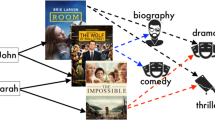Abstract
Recommender systems (RS) are information filtering systems that attempt to predict a user’s rating or preference for an item. It addresses the issue of information overload by providing users with personalized recommendations. RS are typically used for individual recommendations, such as movies, music, and tourists. The tendency-based recommendation technique is easier to use, more convenient, and more precise when compared to the currently available traditional collaborative filtering (CF) techniques. It predicts the final ratings of unrated items using item and user tendency. The personalized tendency approach (PTA) makes recommendations more user-centric using different correlation techniques. We propose two different hybrid approaches to predict the ratings of unrated items. Hybrid approaches are the combinations of Entropy and Clarity-based approach. The recommendations were not user-centric, using only the hybrid approach. This paper merges PTA with the hybrid approach using NHSM similarity. Further, we find a trustee user for an active user. Moreover, we propose a trust-based similarity prediction method. Experimental results show that the proposed approach outperforms the existing methods.

Similar content being viewed by others
Data Availability
Experimented dataset is a standard dataset in the area of recommender systems and is available online
References
Das S, Patra BK, Kumar J (2021) Weighted slope one with threshold filtering. In: Proceedings of the sixth international conference on mathematics and computing, Springer, pp 143–150
Koren Y, Bell R, Volinsky C (2009) Matrix factorization techniques for recommender systems. In: Computer application, IEEE, pp 30–37
Cacheda F, Carneiro V, Fernández D, Formoso V (2011) Comparison of collaborative filtering algorithms: limitations of current techniques and proposals for scalable, high-performance recommender systems. ACM Transactions on the Web (TWEB), ACM, pp 1–33
Sreepada RS, Patra BK, Chakrabarty A, Chandak S (2018) Revisiting tendency based collaborative filtering for personalized recommendations. In: Proceedings of the ACM India joint international conference on data science and management of data. ACM, pp 230–239
Bellogín A, Castells P, Cantador I (2014) Neighbor selection and weighting in user-based collaborative filtering: a performance prediction approach. ACM Transactions on the Web (TWEB), ACM, pp 1–30
Ahn HJ (2008) A new similarity measure for collaborative filtering to alleviate the new user cold-starting problem. In: Information sciences, Elsevier, pp 37–51
Sarwar B, Karypis G, Konstan J, Riedl J (2001) Item-based collaborative filtering recommendation algorithms. In: Proceedings of the 10th international conference on World Wide Web. IEEE, pp 285–295
Wang Jun, De Vries AP, Marcel JTR (2006) Unifying user-based and item-based collaborative filtering approaches by similarity fusion. In: Proceedings of the 29th annual international ACM SIGIR conference on research and development in information retrieval. ACM, pp 501–508
Hao M, Irwin K, Michael LR (2007) Effective missing data prediction for collaborative filtering. In: Proceedings of the 30th annual international ACM SIGIR conference on Research and development in information retrieval. ACM, pp 39–46
Nozari RB, Koohi H (2020) A novel group recommender system based on members’ influence and leader impact. In: Knowledge-based systems. Elsevier, pp 106296
Herlocker Jonathan L, Konstan Joseph A, Terveen Loren G, Riedl John T (2004) Evaluating collaborative filtering recommender systems. In: ACM Transactions on Information Systems (TOIS), ACM, pp 5–53
Yannam VR, Kumar J, Babu KS, Patra BK (2022) Enhancing the accuracy of group recommendation using slope one. J Supercomput 79:499–540
Liu H, Hu Z, Mian A, Tian H, Zhu X (2014) A new user similarity model to improve the accuracy of collaborative filtering. In: Knowledge-based systems, Elsevier, pp 156–166
Bellogín A, Castells P, Cantador I (2011) Predicting the performance of recommender systems: an information theoretic approach. In: Conference on the theory of information retrieval. Springer, pp 27–39
Alhijawi B, Obeid N, Awajan A, Tedmori S (2022) New hybrid semantic-based collaborative filtering recommender systems. Int J Inf Technol 14:3449–3455
Jena KK, Bhoi SK, Mallick C, Jena SR, Kumar R, Long HV, Son NTK (2022) Neural model based collaborative filtering for movie recommendation system. Int J Inf Technol 14:2067–2077
Kumar P, Thakur RS (2018) Recommendation system techniques and related issues: a survey. Int J Inf Technol 10:495–501
Nahta R, Meena YK, Gopalani D, Chauhan GS (2021) Embedding metadata using deep collaborative filtering to address the cold start problem for the rating prediction task. In: Multimedia Tools and Applications, pp 18553–18581
Khoshneshin M, Street WN (2010) Collaborative filtering via euclidean embedding. In: Proceedings of the fourth ACM conference on recommender systems, pp 87–94
Desarkar MS, Sarkar S (2012) Rating prediction using preference relations based matrix factorization, In: UMAP Workshops
Kannan R, Ishteva M, Park H (2014) Bounded matrix factorization for recommender system. Knowl Inf Syst 39(3):491–511
Hernando A, Bobadilla J, Ortega F (2016) A non negative matrix factorization for collaborative filtering recommender systems based on a Bayesian probabilistic model. In: Knowledge-based systems, pp 188–202
Yannam VR, Kumar J, Babu KS et al (2023) Improving group recommendation using deep collaborative filtering approach. Int J Inf Technol 15:1489–1497
Funding
No funding received for this research.
Author information
Authors and Affiliations
Corresponding author
Ethics declarations
Conflict of interest
The authors declare that they have no conflict of interest.
Ethical approval
This is not applicable for this research.
Rights and permissions
Springer Nature or its licensor (e.g. a society or other partner) holds exclusive rights to this article under a publishing agreement with the author(s) or other rightsholder(s); author self-archiving of the accepted manuscript version of this article is solely governed by the terms of such publishing agreement and applicable law.
About this article
Cite this article
Kumar, J., Yannam, V.R., Prajapati, H. et al. Improve the recommendation using hybrid tendency and user trust. Int. j. inf. tecnol. 15, 3147–3156 (2023). https://doi.org/10.1007/s41870-023-01377-6
Received:
Accepted:
Published:
Issue Date:
DOI: https://doi.org/10.1007/s41870-023-01377-6




